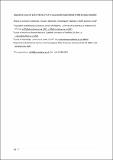Colour as a cue to eat : effects of plate colour on snack intake in pre-school children
Abstract
Environmental cues, such as the colour of food and dishware, have been shown to influence food and drink consumption in adult populations. This proof of concept study investigated whether plate colour could be utilised as a strategy to reduce intake of high energy density (HED) snacks and increase intake of low energy density (LED) snacks in pre-school children. In a between and within-subjects design, children were randomly assigned to either a control group (no colour message) or intervention group (received a colour message: red = stop, green = go) and were provided a snack at nursery on three occasions on differently coloured plates (red, green, white), for each snack type (HED, LED). Snack intake, colour preference, colour association, and anthropometrics were recorded for each child. The results showed that there was no effect of group (control vs intervention) on HED (p=0.540) and LED intake (p=0.575). No effect of plate colour on HED (p=0.147) or LED snack intake (p=0.505) was evident. Combining red and green plates for a chromatic versus achromatic comparison showed that there was no significant effect of chromatic plate on HED (p=0.0503) and LED (p=0.347) intakes. Despite receiving a brief learning intervention, the use of plate colour was found in the present study to be an ineffective strategy to control snack food intake in pre-school aged children. Rather, we suggest that food intake in young children may best be predicted by portion size, energy density and eating behaviour traits
Citation
Carstairs , S A , Caton , S , Hetherington , M , Rolls , B & Cecil , J E 2019 , ' Colour as a cue to eat : effects of plate colour on snack intake in pre-school children ' , Food Quality and Preference , vol. In press , 103862 . https://doi.org/10.1016/j.foodqual.2019.103862
Publication
Food Quality and Preference
Status
Peer reviewed
ISSN
0950-3293Type
Journal article
Description
This work was supported by the BBSRC DRINC fund [grant number BB/M027384/1].Collections
Items in the St Andrews Research Repository are protected by copyright, with all rights reserved, unless otherwise indicated.

